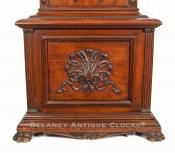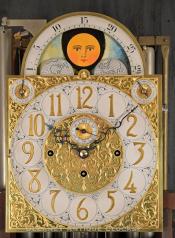J. J. Elliott London movement. Harris and Harrington Pattern No. 9 mahogany case. A quality combination made circa 1910. Wow! This case makes a statement. 222037.
The J. J. Elliott Ltd. clock-making firm in London, England, made this three-train movement housed in the elaborately carved mahogany case by Harris & Harrington. They called this model their "Pattern No. 9."
The works are constructed in brass and are of the highest quality. Four turned pillars support the two large and heavy brass plates. Hardened steel shafts support the polished steel pinions and brass gearing. The three winding drums are grooved to accept the weight-bearing cables. This movement is constructed with retaining or maintaining power. The escapement is a Graham deadbeat design. The flat steel pendulum rod is supported by a brass mount located on the backplate. This rod suspends a brass-faced bob that is weighted with lead. This three-train movement is weight driven and designed to run eight days on a full wind. All three weights are lead and covered in decorative brass casings. The strike train was designed to strike the hours and the quarter hours on a set of 9 tubular chimes of varying lengths. When struck, the sound that resonates is melodious. These are suspended from a bracket that is rigidly mounted inside the case. The operator has a choice of one of three tunes. They include Westminster, Whittington, and St Michaels. The quarter striking feature can be turned on or off by moving a lever located on top of the dial. When this is turned off, the clock will strike each hour on the hour.
The decoratively engraved brass dial features applied details such as chapter rings, numerals, and spandrels. It is signed by the movement maker on the inside edge of the chapter ring located above the hour figure 6. It reads, "ELLIOT – LONDON." This dial features subsidiary seconds with Arabic numerals every ten seconds. The Chime / Strike and Whittington / Westminster / St Michaels selectors are located in the upper corners of the dial. An automated lunar calendar is located in the arch. This dial disk is colorfully painted and displays the phases of the moon.
This carved mahogany case is difficult to describe because the case design is complex. Applied carved decorations, which are challenging to verbally described, are positioned throughout the case structure. In this case, a picture may be worth a thousand words. The carved elements are well executed and done to excess.
This Pattern No 9 stands a total of 8 feet 9 inches tall. It is only 30 inches wide and 20 inches deep when you measure it at the upper bonnet molding. The cabinet is elevated off the floor on four nicely formed animal paw-style feet. A drop swag carving hangs from below the base. The base is decorated with a number of carved elements. A carved shell is the central theme and is centered in the panel. The front corners are fitted with full-length fluted columns that terminate in capitals. The waist section is long, which aids in the narrow proportions of this form. The oval in the door is fitted with beveled glass. Through this, one can see the 9 tubular chimes finished in nickel, three large brass-covered drive weights, and a brass-faced pendulum bob. The sides of the case are also fitted with glass. All three of these panels are decorated with fluid carvings that are light and airy. This is an attractive design element. The columns are skillfully shaped and turned. They are decorated with three-dimensional shaping, carvings, and turning designs. The bonnet or hood features much of the same decorative -style exhibited below. The Swan's neck arches are well formed and exhibit excellent height. Three brass finials surmount the case. Additional carvings are applied to the tympanum. Four hood columns flank the hood door. This example makes a statement and has a fabulous presence.
The case dimensions are as follows: 8 feet 9 inches or 106 inches tall, 30 inches wide, and 20 inches deep. This clock was made circa 1910.
Inventory number 222037.


















